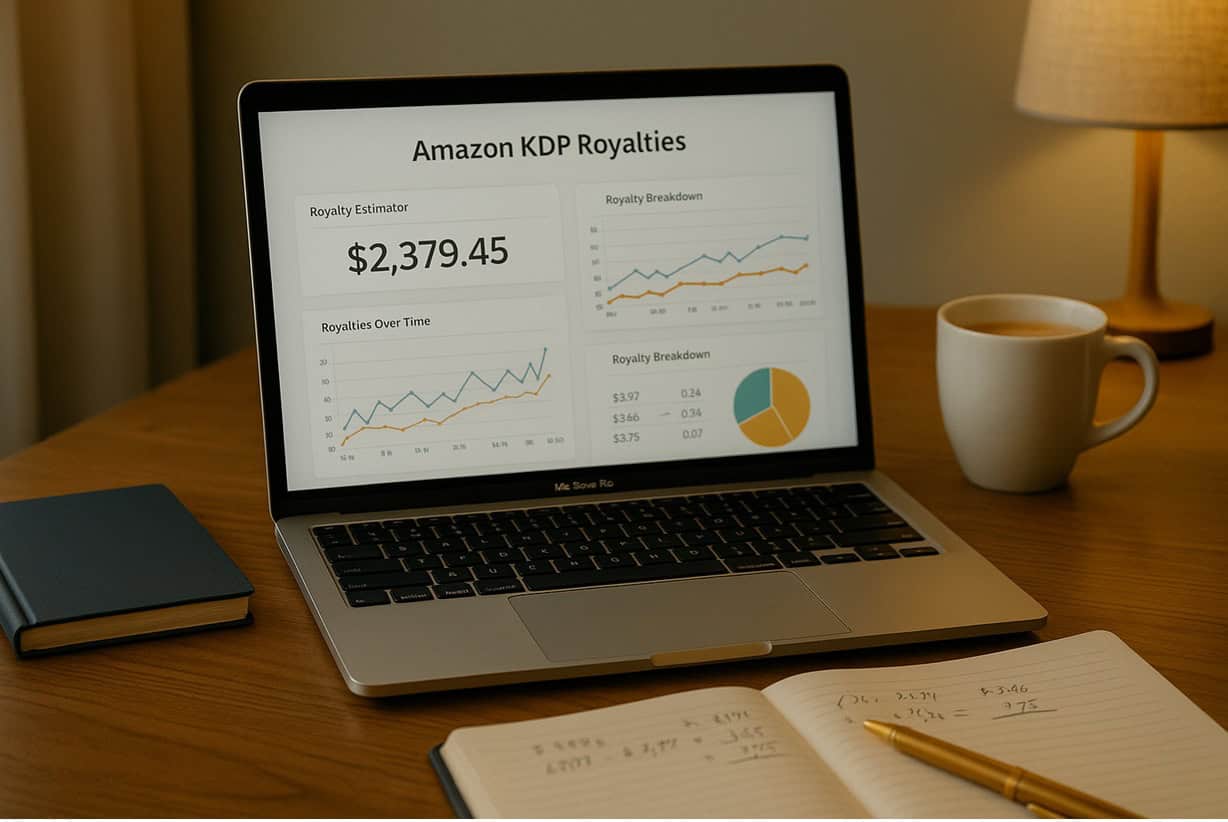Truth About Amazon KDP Royalties and How to Maximize Them
“Writing is art, but publishing is a business. Master both, and your royalties will follow.” — Mark Dawson, Self Publishing Formula
Gain a deep understanding of Amazon KDP royalties and discover smart strategies to maximize your earnings from every sale, whether it’s an eBook, paperback, or hardcover. This knowledge will empower you to make informed decisions and increase your profits without sacrificing reader reach.
Amazon Kindle Direct Publishing (KDP) empowers new indie authors with global access to millions of readers and the ability to earn real income from their books. However, the intricacies of KDP royalties can sometimes be daunting. But once you grasp how they work, you’ll feel confident and in control of your earnings.
For many new indie authors, the difference between eBook and paperback rates, delivery fees, expanded distribution, and pricing rules can lead to lower-than-expected earnings. The good news is that once you understand how KDP royalties are calculated, you can make informed decisions that boost your profits without compromising reader reach.
In this part of our series on self-publishing, you’ll learn how KDP royalty structures actually work in 2025, the key differences between eBook and print earnings, and proven ways to boost your author income.
Step 1: Understand KDP eBook Royalties
When publishing an eBook through Amazon KDP, you’ll choose between two royalty plans: 35% and 70%.
The 70% Royalty Option
You’ll earn 70% of the list price(minus a small delivery fee) if you meet all of the following:
- Your eBook price is between $2.99 and $9.99 (USD)
- The book is sold in eligible territories (U.S., U.K., Canada, Australia, etc.)
- Your file size is reasonable (since delivery fees are based on file size)
- The book isn’t part of a free promotion at the time of sale
Example: If your eBook sells for $4.99 and the delivery fee is $0.10, your earnings would be roughly: ($4.99 – $0.10) × 70% = $3.42 per sale.
The 35% Royalty Option
You’ll earn 35% of the list price if:
- Your eBook price is below $2.99 or above $9.99
- It’s sold in a non-eligible territory
- Or you’ve opted into expanded distribution
Pro Tip: If your book’s genre supports pricing in the $2.99–$9.99 range, always choose the 70% plan—it’s the sweet spot for visibility and profit.
Step 2: Know the Costs That Reduce eBook Royalties.
Understanding the factors that can reduce your royalties, such as delivery fees, VAT or tax adjustments, and currency conversion, is crucial. This knowledge will prepare you to make informed decisions and feel knowledgeable about your earnings.
The royalty you see isn’t the same as what lands in your account. Amazon deducts:
- Delivery fees (based on file size, usually $0.01–$0.15 per MB)
- VAT or tax adjustments (depending on the marketplace)
- Currency conversion for sales in foreign currencies
Keep your file size small by optimizing images and avoiding unnecessary graphics. eBooks under 3 MB are ideal for maintaining profit margins.
Step 3: Understand Paperback Royalties
Paperback royalties work differently. Amazon pays 60% of the list price, minus printing costs.
Formula: (List Price × 0.60) – Printing Cost = Royalty.
Printing costs depend on:
- Page count
- Ink type (black & white vs. color)
- Marketplace (U.S., U.K., EU, etc.)
- Paper type (white, cream, premium color)
Example:
A 250-page black-and-white paperback priced at $12.99:
Printing cost ≈ $3.25 → ($12.99 × 0.60) – $3.25 = $4.54 royalty per sale.
Pro Tip: Every additional 50 pages incurs an extra cost. Tighten spacing, eliminate excess blank pages, and review your trim size for savings.
Step 4: Expanded Distribution Explained
If you enable Expanded Distribution, Amazon makes your paperback available to bookstores and libraries through wholesale channels.
However, the royalty rate drops to 40% (minus printing costs).
Use this only if:
- You want potential bookstore visibility.
- You don’t plan to publish through IngramSpark (which offers wider distribution).
For most indie authors, Amazon’s standard 60% rate is more profitable.
Step 5: Hardcover Royalties
Hardcover options on KDP royalties offer 60% minus printing costs, similar to paperback royalty rates.
However, hardcovers are more expensive to print, so net earnings are often smaller.
If you publish a hardcover edition:
- Price it high enough to maintain profit (usually $16.99–$22.99).
- Treat it as a premium option for collectors, libraries, or special editions.
Step 6: Maximize Your Royalties with Smart Pricing
Pricing isn’t guesswork. It’s strategy.
Tips to Earn More:
- Price for psychology. $4.99 often outsells $5.00 because it feels lower.
- Experiment. Adjust prices every few months and track results.
- Bundle books. Box sets or trilogies often outperform single titles.
- Use Kindle Countdown Deals if you’re in KDP Select—temporary discounts can spike visibility and overall income.
- Monitor your reports. KDP dashboards show which marketplaces and formats earn best—use that data to refine pricing.
Pro Tip: A small price drop that doubles your sales volume often earns more overall.
Step 7: Don’t Forget Kindle Unlimited (KDP Select)
If you enroll your eBook in KDP Select, it becomes available in Kindle Unlimited (KU) and Kindle Owners’ Lending Library (KOLL).
You won’t earn a flat sale price. Instead, you’re paid per page read, funded by the KDP Global Fund.
As of 2025, payout averages around $0.0045 to $0.005 per page.
That means a 300-page novel read completely earns about $1.35–$1.50 per reader.
How to Maximize KU Earnings
- Write in series; KU readers love binge-reading.
- Add clear calls-to-action at the end of each book (link to the next in the series).
- Use KU promos like “Free Days” or “Countdown Deals” strategically.
Pro Tip: KU is ideal for genre fiction authors looking to build a loyal audience. Non-fiction or wide-distribution authors may prefer staying out.
Step 8: Track Your Sales and Optimize Over Time
Royalties are dynamic. They change with trends, territories, and reader behavior.
Tools that help:
- Book Report – Visualize sales and royalties more clearly than KDP’s native dashboard.
- ReaderScout (Chrome Extension) – Track your book’s ranking and category performance in real time.
- ScribeCount – Aggregates sales data from multiple platforms if you publish wide.
Regularly review:
- Top-earning marketplaces
- Price performance
- Page reads vs. sales ratio
- Seasonal sales spikes (holiday, back-to-school, etc.)
The more you analyze, the better you can adjust pricing, marketing, and promotions for maximum profit.
Key Takeaway
Amazon KDP royalties can seem confusing, but once you break them down, the numbers start to make sense.
The key takeaway? You have more control than you think. By pricing strategically, optimizing file sizes, and understanding each royalty structure, you can increase your earnings and keep more money from every book sale.
Publishing isn’t only about being creative. It’s your author business. Learn the system, work smart, and your royalties will reflect it.
Checklist: Maximize Your KDP Royalties
- Choose the 70% royalty option whenever possible
- Keep your eBook file under 3 MB to reduce delivery fees
- Calculate paperback printing costs before setting price
- Compare KDP vs. Expanded Distribution for profitability
- Price strategically within reader expectations
- Use Kindle Countdown Deals and KU promos wisely
- Track royalties with Book Report or ScribeCount
- Test prices quarterly and monitor performance
- Review royalty statements monthly to spot trends
We hope you found this writer’s guide series on self-publishing helpful and inspiring. The articles are intended to provide you with the necessary tools and insights to succeed as an indie author.
For more guidance, see other writer’s guides in the series, such as Amazon KDP Made Easy—7 Steps for Self-Publishing.
If you have a draft and want to explore how AI can help you self-publish it, read, Is Your Book Ready to Self-Publish? Lastly, for help writing a non-fiction book, read Write Your First Non-Fiction eBook: a 30-Day Workbook for Getting It Done.
Writing is an ongoing adventure that involves continuous learning and improvement. You don’t have to go through this alone. We are excited to accompany you every step of the way, providing you with the support and motivation you need. Our goal is to give you the necessary knowledge and practical advice to navigate the world of writing with confidence.
Don’t wait. Start today! How can we help? To let us know, please fill out our Contact form. Happy writing!

